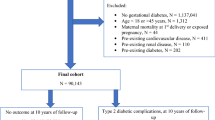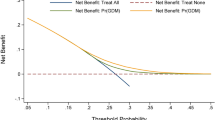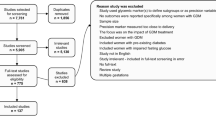Abstract
Objective:
To evaluate the role of education level in predicting the risk of macrosomia among women with gestational diabetes mellitus.
Study design:
Women with gestational diabetes, who were referred to the California Diabetes and Pregnancy Sweet Success Program between June 2001 and December 2002, were included in the study. Multiple logistic regression was used estimate the risk of macrosomia, defined as a birth weight >4000 g.
Results:
Compared to college-educated women, high school- and middle school-educated women were 21% (relative risk (RR), 1.21; 95% confidence intervals (CI), 1.01–1.44) and 35% (RR, 1.35; 95% CI, 1.09–1.70) more likely to deliver a macrosomic infant, respectively.
Conclusion:
Gestational diabetics with a lower level of educational attainment appear to have an increased risk of macrosomia. Future studies are necessary to determine whether this finding reflects a variation in adherence to recommended treatments by education/literacy level, or if it is a surrogate marker for intrinsic, biological differences or differences in lifestyle.
This is a preview of subscription content, access via your institution
Access options
Subscribe to this journal
Receive 12 print issues and online access
$259.00 per year
only $21.58 per issue
Buy this article
- Purchase on Springer Link
- Instant access to full article PDF
Prices may be subject to local taxes which are calculated during checkout
Similar content being viewed by others
References
Gabbe SG, Graves CR . Management of diabetes mellitus complicating pregnancy. Obstet Gynecol 2003; 102: 857–868.
Coustan DR . Gestational Diabetes. National Institutes of Diabetes and Digestive and Kidney Diseases. Diabetes in America, 2nd Edn. NIDDK: Bethesda, Maryland, 1995; 95-1468: 703–712.
American College of Obstetricians and Gynecologists. Gestational diabetes. ACOG Practice Bulletin, No 30. ACOG: Washington, DC, September 2001.
Garner P, Okun N, Keely E, Wells G, Perkins S, Sylvain J et al. A randomized controlled trial of strict glycemic control and tertiary level obstetrics care versus routine obstetric care in the management of gestational diabetes: a pilot study. Am J Obstet Gynecol 1997; 177: 190–195.
Naylor CD, Sermer M, Chen E, Sykora K . Cesarean delivery in relation to birth weight and gestational glucose tolerance. JAMA 1996; 275: 1165–1170.
Lu G, Rouse D, Dubard M, Cliver S . The impact of lower threshold values for the detection of gestational diabetes mellitus. Obstet Gynecol 2000; 95: S44.
Adams KM, Li H, Nelson RL, Ogburn Jr PL, Danilenko-Dixon DR . Sequelae of unrecognized gestational diabetes. Am J Obstet Gynecol 1998; 178: 1321–1364.
Acker DB, Sachs BP, Friedman EA . Risk factors for shoulder dystocia. Obstet Gynecol 1985; 66: 762–768.
Langer O, Berkus MD, Huff RW, Samueloff A . Shoulder dystocia: should the fetus weighing greater than or equal to 4000 grams be delivered by cesarean section? Am J Obstet Gynecol 1991; 165: 831–837.
Vohr BR, McGarvey ST, Tucker R . Effects of maternal gestational diabetes on offspring adiposity at 4–7 years of age. Diab Care 1999; 22: 1284–1291.
Silverman BL, Metzger BE, Cho NH, Loeb CA . Impaired glucose tolerance in adolescent offspring of diabetic mothers. Diab Care 1995; 18: 600–617.
Crowther CA, Hiller JE, Moss JR, McPhee AJ, Jeffries WS, Robinson JS . Effect of treatment of gestational diabetes mellitus on pregnancy outcomes. N Engl J Med 2005; 352: 2447–2486.
deVeciana M, Major C, Morgan MA, Asrat T, Toohey JS, Lien JM et al. Postprandial versus preprandial blood glucose monitoring in women with gestational diabetes requiring insulin therapy. N Engl J Med 1995; 333: 1237–1241.
Langer O, Rodriguez DA, Xenakis EM, MacFarland MD, Berkus MD, Arrendondo F . Intensified versus conventional management of gestational diabetes. Am J Obstet Gynecol 1994; 170: 1036–1047.
Schillinger D, Grumbach K, Piette J, Wang F, Osmond D, Daher C et al. Association of health literacy with diabetes outcomes. JAMA 2002; 288: 475–482.
Goujard C, Bernard N, Sohier N, Peyramond D, Lancon F, Chwaloe J et al. Impact of a patient education program on adherence to HIV medication: a randomized clinical trial. J Acquir Immune Defic Syndr 2003; 34: 191–194.
Goldman DP, Smith JP . Can patient self-management help explain the SES health gradient? Proc Natl Acad Sci USA 2002; 99: 10929–10934.
California Diabetes and Pregnancy Program Fact Sheet. California Diabetes and Pregnancy Program Website. at http://www.mch.dhs.ca.gov/programs/cdapp/cdappfacts.htm,accessed 8/6/05.
The California Diabetes Program Website. at http://www.caldiabetes.org/profile_display.cfm?CategoryID=21&ProfileID=88,accessed 3/19/06.
Latha MJ . Estimating risk: is there an association? In: Gordis L (ed). Epidemiology, 2nd edn. W.B. Saunders Company: Philadelphia, 2000.
Mooney C, Duval RD . Bootstrapping: A Nonparametric Approach to Statistical Inference. Sage Publications: Beverly Hills, CA, 1993.
Efron B, Tibshirani RJ . An Introduction to the Bootstrap. Chapman and Hall/CRC: New York, 1998.
Hosmer DW, Lemeshow S . Applied Logistic Regression, 2nd edn. John Wiley and Sons, Inc: New York, 2000.
American College of Obstetricians and Gynecologists. Fetal Macrosomia. ACOG Practice Bulletin, No 22. ACOG: Washington, DC, November 2000.
Chung JH, Boscardin WJ, Garite TJ, Lagrew DL, Porto M . Ethnic differences in birthweight by gestational age – at least a partial explanation for the latino epidemiological paradox? Am J Obstet Gynecol 2003; 189: 1058–1062.
Schillinger D, Piette J, Grumbach K, Wang F, Wilson C, Daher C et al. Closing the loop: physician communication with diabetic patients who have low health literacy. Arch Intern Med 2003; 163: 83–90.
Doak CC, Doak LG, Friedell GH, Meade CD . Improving comprehension for cancer patients with low literacy skills: strategies for clinicians. CA Cancer J Clin 1998; 48: 151–162.
Acknowledgements
The authors wish to thank Ms Jennifer Lambert, previously with the University of California, San Diego, for kindly supplying the data necessary for this study to be performed, and Ms Maribeth Inturrisi, Coordinator and RN Educator Consultant for the California Diabetes and Pregnancy Program, for input on the manuscript. Analyses, interpretations, and conclusions are by the authors of this study and not by Ms Lambert, Ms Inturrisi, the California Department of Health Services, Maternal Child Health Branch, or the California Diabetes and Pregnancy Program Data System.
Author information
Authors and Affiliations
Corresponding author
Additional information
Financial Support: None.
Rights and permissions
About this article
Cite this article
Chung, J., Voss, K., Caughey, A. et al. Role of patient education level in predicting macrosomia among women with gestational diabetes mellitus. J Perinatol 26, 328–332 (2006). https://doi.org/10.1038/sj.jp.7211512
Received:
Revised:
Accepted:
Published:
Issue Date:
DOI: https://doi.org/10.1038/sj.jp.7211512
Keywords
This article is cited by
-
Development and initial testing of a GDM information website for multi-ethnic women with GDM
BMC Pregnancy and Childbirth (2015)



